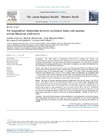The longitudinal relationship between nutritional status and anaemia among Malaysian adolescents

Abstract
Introduction: The triple burden of malnutrition characterised by stunting and wasting, overweight/obesity, and anaemia experienced by Malaysians causes severe and long-lasting damage during the period of development and rapid growth, particularly in adolescence. This study aimed to demonstrate the trend of anaemia prevalence and to determine its longitudinal association with nutritional status and lifestyle among Malaysian adolescents.
Method: The study involved secondary data analysis from the Malaysian Health and Adolescents Longitudinal Research Team (MyHeART) study. A closed cohort secondary data analysis was performed from the dynamic cohort of 528 adolescents (male = 151; female = 377) aged 13 years attending secondary school who were followed up at 15 and 17 years. Anaemia status was determined by haemoglobin level < 12g/dL based on FBC, and iron deficiency anaemia (IDA) was determined when the Mentzer Index < 13. A generalised estimating equation (GEE) was constructed to investigate the longitudinal relationship between nutritional status and lifestyle on anaemia status over five years.
Results: The trend of anaemia prevalence increased significantly across the age group (7.9%; 95% CI: 2.3-11.1, 13.9%; 95% CI: 10.8-15.7 and 15.8%; 95% CI: 3.8-23.1) at 13, 15 and 17 years, respectively, especially among females. The trend of anaemia prevalence among females, also increased significantly across the age group (11.1%;95% CI:6.7-17.8, 15.7%;95% CI:11.4-21.3, 23.1%;95% CI:16.8-31.0). A similar trend was noted for the prevalence of IDA among those who were anaemic (66.5%; 95% CI: 40.4-85.3, 72.2%;95% CI: 54.8-85.4, 76.3%; 95% CI: 59.2-87.7). A longitudinal analysis using GEE revealed that adolescents who did not meet the Recommended Nutrient Intake (RNI) for total iron intake per day were significantly associated with anaemia (RR=1.517;95% CI: 1.012-2.275; p=0.044) and IDA (RR=1.776;95% CI: 1.225-2.57; p= 0.002).
Conclusion: The overall trend of anaemia among adolescents is in increasing trend and anaemia is prevalent among female adolescents in this study. It is crucial to understand that the current fortification strategy may need to be revisited, and robust intervention programmes are necessary and should be sex specific.
Collections
Date
2021-10Author
Krishnan, Vanitha
Zaki, Rafdzah Ahmad
Nahar, Azmi Mohamed
Jalaludin, Muhammad Yazid
Majid, Hazreen Abdul